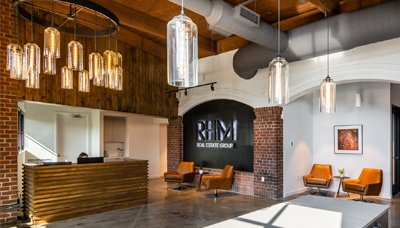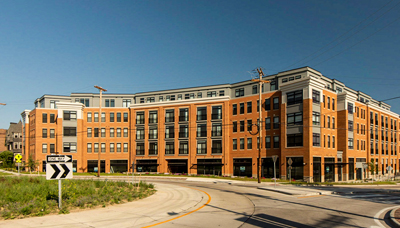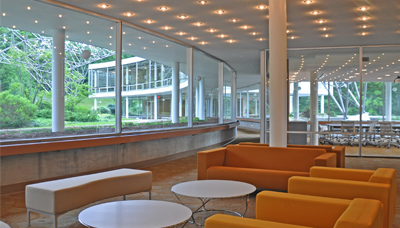“The Metropolis of the Western Reserve Reclaims its Urbanity”
By Steve Litt, Architectural Record
Cleveland has long been ridiculed as a dysfunctional city bisected by the once-infamous Cuyahoga River, where oil-soaked debris caught fire in 1969. Yet today more than 40 species of fish live in the far cleaner Cuyahoga, crew teams ply its curves, and the $250 million Flats East Bank development, with an 18-story office tower, hotel, nightclubs, and apartments, is rising amid the numerous bridges that link the city’s halves. Burning River, meanwhile, is the name of a pale ale made by the local Great Lakes Brewing Company- a signal of counterintuitive pride in the city’s big moment of shame, and a measure of how far it’s come since then.
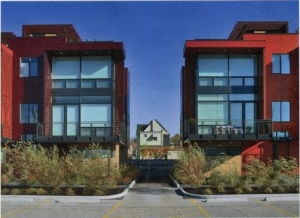
Cleveland-based Dimit Architects’ 27 townhouses in Little Italy, near University Circle, hit the market in early 2009- not the most auspicious time for real estate. Perhaps because of their flexible floor plans, industrial aesthetic (the property was a former brownfield), and proximity to the city’s largest employers, all of them sold in two and a half years. The three-story houses, clad in cement board and phenolic panels, contain 1,600 to 3,400 square-foot loftlike units with roof terraces.
Though its population has shrunk to just below 400,000 from nearly 1 million in the 1950’s. Cleveland is experiencing a $6 billion burst of development that includes everything from big downtown projects to the fine-grain revival of a half-dozen neighborhoods. An influx of young professionals, drawn by jobs in tech, digital media, marketing, and biomedical companies, has led to a tight downtown rental market with a residential population of about 10,000 and growing, and an occupancy rate of nearly 96 percent.
Michael Christoff, a 30-year-old architectural designer who grew ip in rural Canfield, Ohio, says he decided to stick around Cleveland after graduating from Kent State University in 2004 with a bachelors degree in architecture because he saw new opportunities in a city young people once fled. “If you’ve got ideas and you’re passionate enough to put the work into doing them, people in Cleveland will support you,” he says. “You can engage and get traction.”
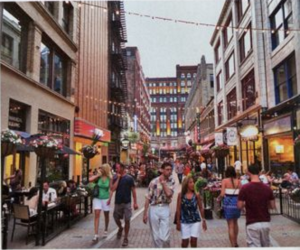
EAST FOURTH STREET: Fifteen years ago, wig shops dominated East Fourth Street; the wigs in the windows were color-coded to correspond to the drugs for sale inside. In 2000, local developer MRN Ltd. used historic tax credits and abatements to begin to buy out 250 owners and create 224 apartments, for which there’s now a 400-person waiting list. More than a dozen restaurants, a House of Blues, and a bowling alley keep the lantern-strewn strip buzzing. Downtown need retail and more residents, but East Fourth Street helped jump-start the revitalization
The change in Cleveland is readily visible four miles east of downtown in the University Circle neighborhood, the fast-growing cultural and education hub, which is also home to University Hospitals and the world-famous Cleveland Clinic, the city’s largest employers, with a combined staff of nearly 30,000. To stand there on Euclid Avenue, once notable for its Millionaires’ Row mansion, is to catch a glimpse of a city capitalizing on one square mile of legacy institutions set among greenways designed a century ago by Frederick Law Olmsted, Jr. Fresh investments in the district include a $350 million expansion of the Cleveland Museum of Art, designed by Rafael Vinoly (page 114), and the new home of the Museum of Contemporary Art Cleveland (MOCA), a shiny gemstone in black, reflective stainless steel by Farshid Moussavi. MOCA anchors the eight-acre Uptown development, on the flank of Case Western Reserve University, which includes apartments, a bookstore, a supermarket, nightclubs, and restaurants wrapped in crisp geometric, aluminum-clad buildings designed by Stanley Saitowitz/Natoma Architects of San Francisco (page 110).
Such projects raise the possibility that other shrinking cities across the industrial Great Lakes could build a brighter future on similarly rich assets such as medical and cultural institutions, universities, specialized manufacturing, and handsome early-2oth-century neighborhoods. Also key is a relatively low cost of living and a vast supply of Great Lakes water, now much improved in quality after decades of environmental regulation originally inspired by a certain burning river.
State and federal historic-preservation tax credits and other forms of public-sector leverage, including large-scale mass-transit improvements, have triggered many of the new projects. The Regional Transit Authority’s new $200 million rapid bus line on Euclid Avenue, modeled on an award-winning fast boarding system in Curitiba, Brazil, has boosted ridership with faster headways and shiny silver buses. It also provided the impetus to rebuild crumbling Euclid Avenue. That investment- 80 percent of it in federal funds- has reinforced or leveraged more than $1 billion in devlopment in University Circle alone, says Chris Ronayne, director of University Circle Inc., the area’s nonprofit community-development corporation. “This was an intentional effort to bring back our historic Main Street.” he says.
To be sure, Cleveland still struggles with poverty, racial tension, and poor public schools. Its shrinking population means the city is losing political clout in Congress and in the politically fragmeneted northeast Ohio region, where most of the 3.8 million residents live in sprawl suburbs and rarely go downtown. Yet several decades of patient stewardship by its cultural institutions, universities, foundations and developers is paying off in selected parts of the city.
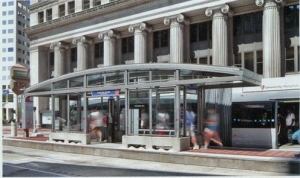
The nine mile, $200 million bus rapid-transit line, the RTA Healthline, launched in October 2008, transporting passengers adjacent to and along Euclid Avenue, a grand corridor once known as Millionares’ Row, which went into a spiral of deterioration and neglect after the Great Depression. Decades in the imagining, the transit line is now credited with helping to attract $5.8 billion in investments for new construction and rehabilitation on Euclid. Hybrid rapid-transit vehicles stop at 40 stations and connect two growing areas, University Circle and downtown Cleveland.
Efforts to improve social equity are part of the package. The Cleveland Foundation, the nation’s oldest community foundation, with assets of over $1 billion, persuaded University Hospitals and the Cleveland Clinic to spread their wealth into the surrounding poor, predominately African-American neighborhoods by patronizing local employee-owned cooperatives such as laundries and urban greenhouses.
The Cleveland Foundation also cajoled the Northeast Ohio Regional Sewer District to work with Kent State University’s Cleveland Urban Design Collaborative and others on a $3 billion project to cut pollution from the aging combined and storms and sewer systems. The collaboration is part of KSU’s “Reimagining Cleveland,” an influential study of how the city could reuse neighborhoods hollowed out by population loss and foreclosures for parks, agriculture, constructed wetlands, and trails. “It’s about nothing less than creating a sustainable framework for reviving the city.” says Terry Schwartz, who heads the KSU program. “Rather than let the voids dilute the city, we have to think about putting vacant land back into productive but nontraditional uses.”
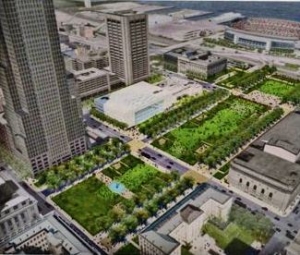
Slated for completion in July 2013, LMN Architects’ Medical Mart and the Cleveland Convention Center underground are rising in tandem with the revival by Gustafon Guthrie Nichol (GGN) of Daniel Burnham’s 1903 downtown Mall (below). Together, the projects aim to bring the public back to the city center and reconnect a greener, unified Mall with the lakefront. GGN’s long-term plan for the Mall includes “outdoor rooms” to accommodate flexible programming and lighting to showcase beautiful historic buildings.
The new projects across Cleveland are adding a fresh layer of architecture and landscape to the handsome civic armature established during the late 19th and early 20th centuries by industrial barons who built immense fortunes in oil, steel, mining, and banking, included John D. Rockefeller, industrial magnate John Long Severance, and Jeptha H. Wade, a founder of the Western Union Telegraph Company. “We inherited incredible bones, then we figured out how to take these wonderful old buildings and give them new uses.” says the developer Ari Maron of MRN Ltd. Outside the historic core, prior attempts at revitalization include the less-than-succesful Erieview urban-renewal district, conceived in 1961 by a young LM. Pei. The project erased 200 acres of downtown density and filled the ensuing voids with bland Modernist towers now struggling to keep tenants.
Though considered the Midwest, Cleveland clings to its New England roots as part of a territory once termed the Western Reserve of Connecticut, first surveyed by Moses Cleaveland in 1796. He laid the plans for a 10-acre public square and downtown grid atop a 70-foot-high bluff that rises above Lake Erie and the Cuyahoga River. Downtown is still dominated by landmarks, such as the Neoclassical 1931 Terminal Tower, and by one of the largest intact City Beautiful districts in the country, designed in 1903 by Daniel Burnham. Part of the district will be relandscaped by Gustafon Guthrie Nichol of Seattle atop a new, below-grade convention center, designed by LMN Architects, also of Seattle. The $465 million project includes the nation’s first Medical Mart, a showroom for advanced medical devices, set to open next year. Almost 20 years ago, Cleveland pegged its hopes for rebirth on such big, taxpayer-bankrolled projects as the Browns stadium and the Rock and Roll Hall of Fame, a mediocre building designed by an older L.M Pei, plopped on the drab lakefront. The projects insured that the city retained its major-league teams and attracted tourists, but did nothing to improve streetscapes or the poorly planned Lake Erie shoreline, cut off from downtown by a railroad and an interstate highway.

The newest addition to a group of local, worker-owned cooperatives, this four-acre greenhouse on a 10-acre site (above) in the Central neighborhood will be complete by mid-November; the first crop of leafy greens and herbs will be harvested in January. The greenhouse will supply 3 million heads of lettuce and 300,000 pounds of herbs per year, to be sold to the area’s largest employers (Case Western Reserve University, University Hospitals, and the Cleveland Clinic) and retail groceries. Initially, the greenhouse will employ 20 to 25 people from the surrounding neighborhoods, where the median income is less than $18,500. A percentage of the profits will be distributed back to the employees.
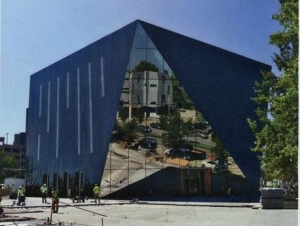
Farshid Moussavi’s first building in the U.S., on the corner of Euclid Avenue and Mayfield Road, adds another jewel to University Circle’s crown when it opens this month. It is also a powerful urban accent in relationship to it’s neighbor, Stanley Saitowitz’s mixed-use Uptown project. The four-story, 34,000-square-foot hexagon is clad in mirrored, black stainless-steel panels. A glass atrium will contain a small cafe and lounge, doubling as an event space. MOCA’s new $27.2 million home includes three galleries, an education room, and offices. Exposed fluted metal decking painted a deep blue dominates the interior, which is punctuated by a sculptural steel staircase. -Captions by Laura Raskin
The once-elegant downtown, its broad streets nearly empty of shops, is still quiet these days, but there are pockets of vibrancy. Along East Fourth Street, in the shadow of the Gateway ballpark and basketball arena, also built in the 1990’s MRN Ltd. gentrified a dingy block of wig shops and greasy spoons, turning it into a regional hotspot for nightlife. Anchors on the street include Lola Bistro, one peice of a growing restaurant empire concieved by Iron Chef Micheal Symon- part of the city’s booming lovacore gourmet movement- and the House of Blues, where you might catch one of the regular Pecha Kucha nights. In those alcohol-fueled networking events, young creatives strut their ideas in successive six-minute-and-40-second presentations on everything from art and fashion design to comedy, ceramics, and community redevelopment. “The energy is pretty awesome,” says designer Christoff, and organizer of the events. If at least some of those twenty- or thirysomethings stick around to grow new companies and raise families, Cleveland just might achieve its dream: a self-sustaining wave of reinvestment that leads the way to an even bigger rejuvenation.
Steven Litt is the architecture critic of the Plain Dealer in Cleveland.

